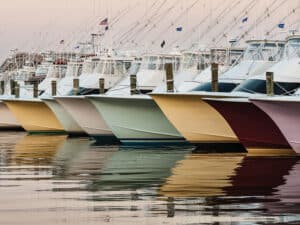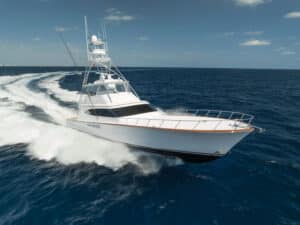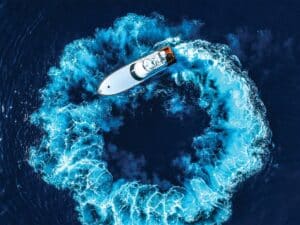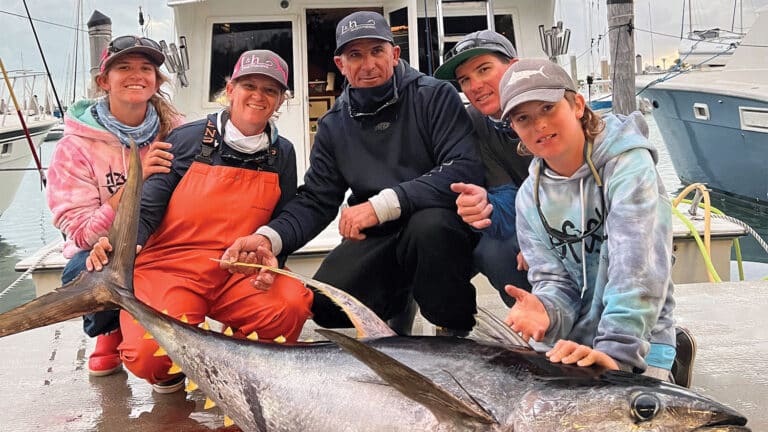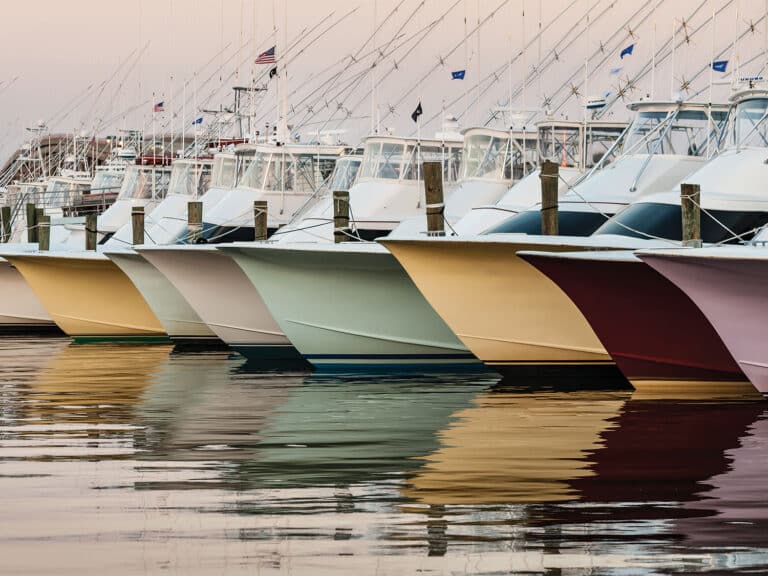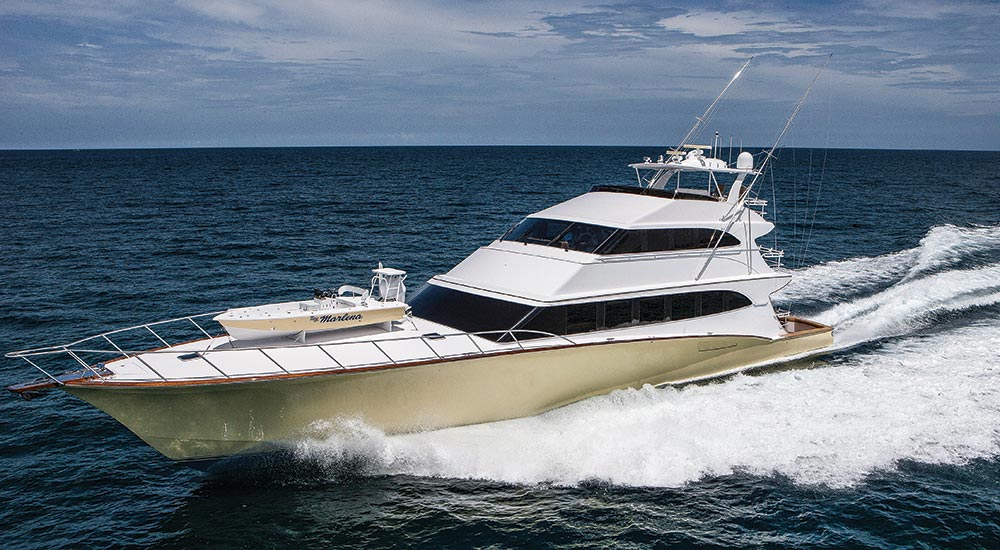
You don’t have to be an old-timer to remember when a 60-footer was considered a big sport-fishing boat — maybe even too big. Many felt bigger boats weren’t maneuverable enough to keep up with a greyhounding blue marlin, or a quadruple-header of sailfish heading for separate points of the compass. Yet today, we see 80-, 90-, and even 100-plus-footers showing up on the water and at tournament weigh-ins with regularity. Boats once considered too big to fish seriously are winning tournaments left and right.
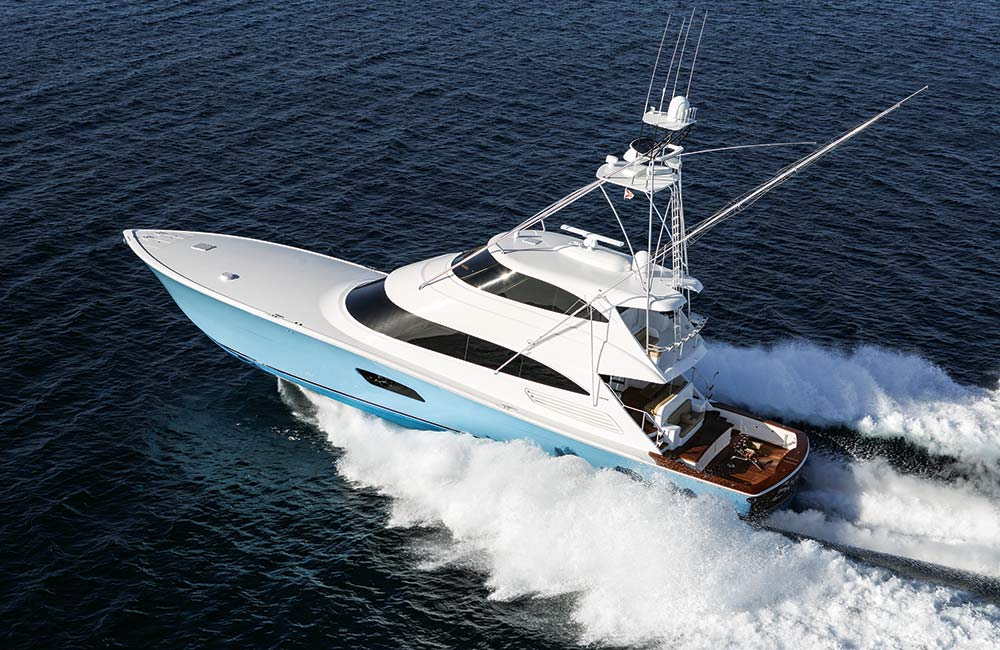
In July 2017, Fa La Me, a 92-foot Viking owned by Frank Rodriguez and captained by Rob Moore, won the Bermuda Triple Crown with the highest point total in the history of the series, also becoming the first-ever three-time Triple Crown winners. Angler Kevin Pento earned a Master Angler ring aboard the 90-foot Bayliss Boatworks Singularis at the 2017 White Marlin Open. The 95-foot Jim Smith Relentless Pursuit took home a win in the wahoo division at the 2017 Blue Marlin Grand Championship, and then third place for tuna in the 2017 Orange Beach Billfish Classic; in that same tournament, the second-place catch-and-release boat was the 92-foot Viking, A Work of Art. The list goes on, with endless tournament results proving beyond a shadow of a doubt that big boats — really big boats — can indeed compete effectively on the tournament circuit.
Does Size Really Matter?
Have technological advances made these monster fishing yachts more fishable? Are there new tactics and techniques that can overcome the downsides to fishing from a large, lumbering platform? John Bayliss, a competitive captain-turned-boatbuilder, has insight from both sides of the coin.
“I remember the days of seeing a 60-footer and wondering, ‘How the heck could anyone fish from a boat that big?’” Bayliss says. “But that’s changed big-time, and today, the 60 is the little boat in the shop.”
As anglers and captains alike might assume, one of the biggest challenges that come with fishing competitively from a massive sport-fishing machine has always been maneuverability — and this is the key factor each and every captain and builder we spoke with raised. But in this regard, technology has in fact helped overcome the challenge.
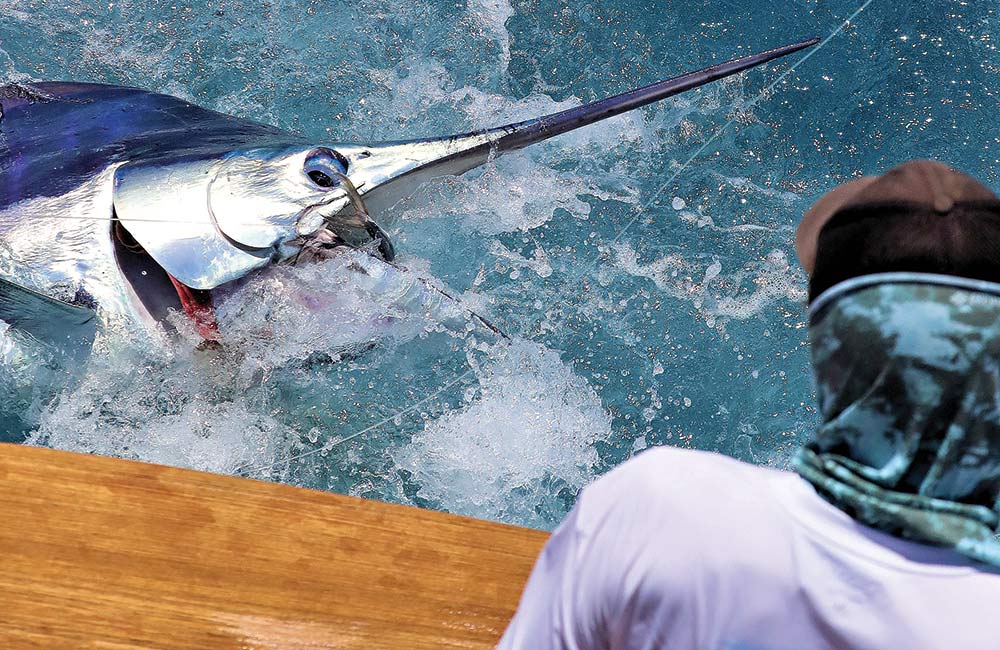
“Today’s powerplants have helped tremendously in making these larger boats more nimble,” Bayliss says. “Taking a 150,000-plus-pound boat and aggressively spinning it around on a tripleheader or a wild blue marlin is now possible, especially when you incorporate a hydraulic bow thruster.”
Capt. Mel Matherne, who runs the 105-foot Jim Smith Marlena, points to the exact same factor. “When backing down, the bow thruster can be a big help,” he reports. “Maneuverability is not a problem at all on Marlena, regardless of size. In fact, even boats as big as 105 feet can feel like you’re just handling a really big Ferrari.”
And on Fa La Me, Moore has had a similar experience. “It took a while to get used to it,” he says, “but in truth, the boat is just as agile as a smaller boat that was built 10 years ago.” In the case of the 92-footer he runs, Moore gives much of the credit to Viking. “The Viper steering” — a proprietary system developed specifically for Viking’s larger sport-fishing yachts — “allows me to make turns in a radius that is just as tight as a much smaller boat,” he says.
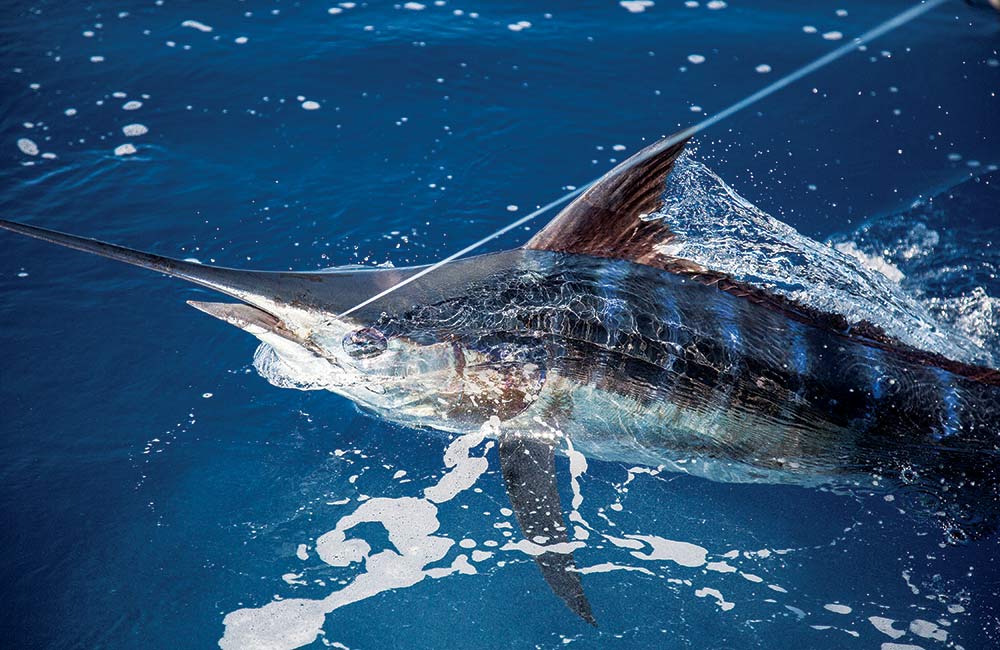
The builders of these larger boats also point out that advancements in the available powerplants have a lot to do with their ability to go larger. “It’s all about the horsepower,” says Jim Weaver, of Weaver Boatworks, which launched a 90-footer last year and currently has a 97 under construction. “A decade ago, we didn’t have the MTU 2400s or 2600s. On top of that, now we also have better propeller designs and faster throttle response. The delay that used to be in the throttle is gone, and we’ve also got gyrostabilizers, joystick controls, and a lot of different advancements that all play a part in allowing the boats to go bigger.”
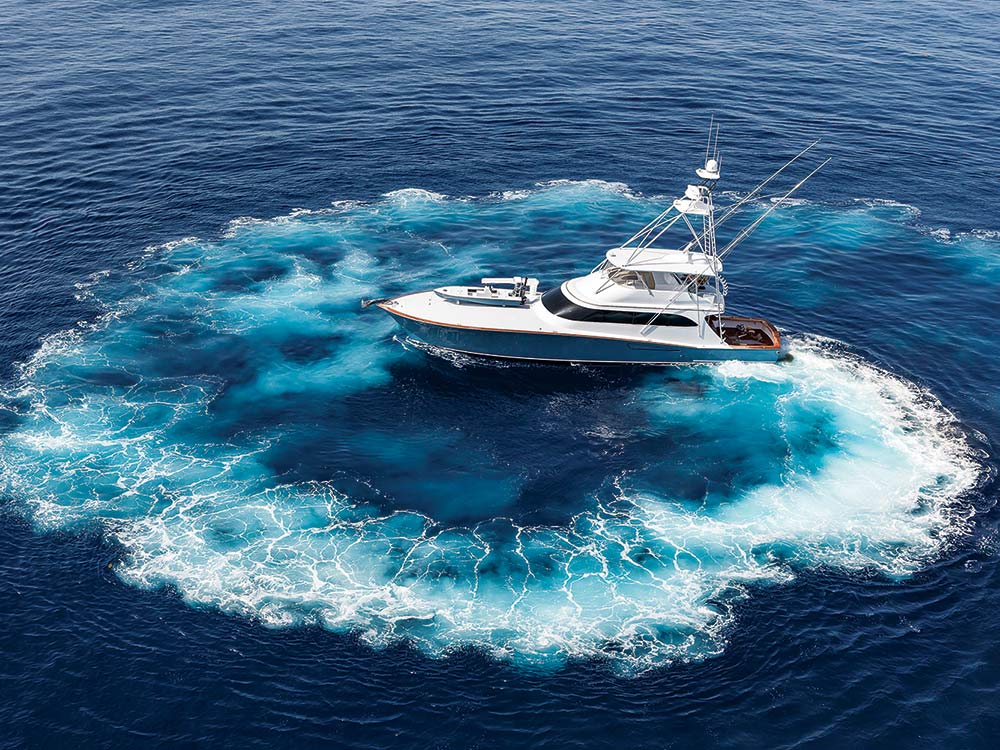
Ryan Higgins, factory captain at Viking Yachts, points to horsepower and throttle response as the key factors as well. “Available horsepower is one of the crucial mechanical items needed to keep these big sport-fishing boats competitive,” he explains. “The MTU M91s pushed our initial 74 at a 30-plus-knot cruise. Then the M93 pushed the 82 at a 30-knot cruise. Then came the first set of M96L 2600s in North America, which powered the first 92 Convertible and produced cruise speeds over 30 knots. There’s no delay in the control system, and the acceleration and responsiveness make the 92 maneuver more along the lines of a 60-footer.”
 |
Subscribe Now and Save 68% |
Growing Pains
With the maneuverability issues resolved, sheer size does expose some different issues with fishing competitively from yachts of this length. The size of the crew, for example, needs to grow with the boat. No one we spoke with fished with just a captain and a mate: Three hands are considered the minimum number. Some mentioned bring a fourth aboard for tournament fishing. And the more crew you have running a boat, the more imperative it is that they all work as a team. All of the captains we spoke with stressed the need to get everyone on the same page in the cockpit.
"The biggest thing about running the operation on a big boat like this is that everyone knows and does their job," says Fa La Me's Moore. "Everything has to be as organized as possible, and if there's a problem, it's almost impossible to play catch-up. It's sort of like driving a semi through the city: There isn't much room for error."
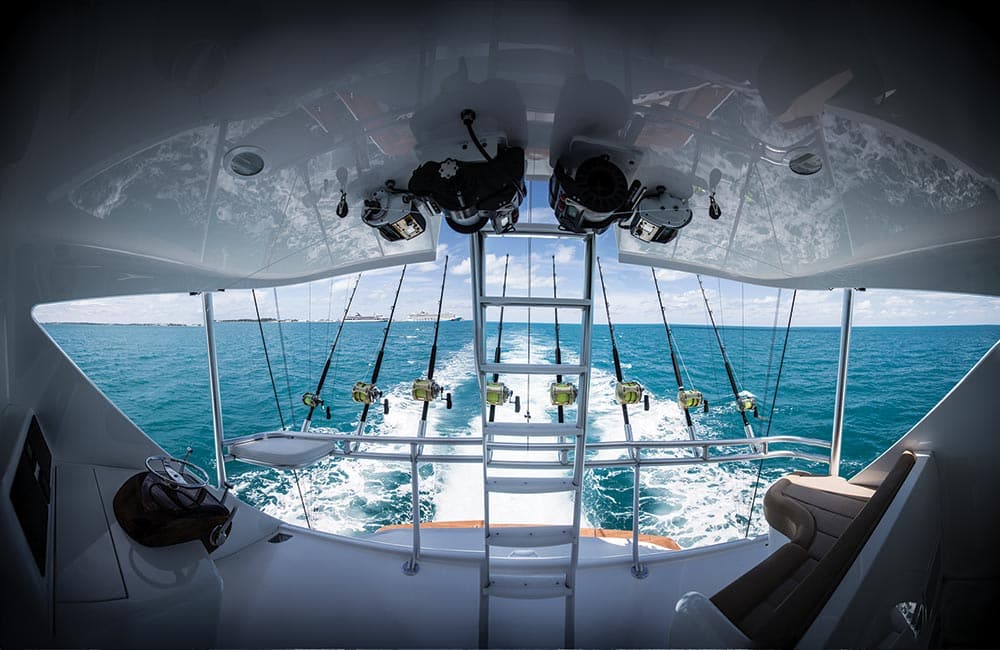
A mistake that does pop up might be a result of overreaching. Naturally, everyone wants to make the most of all the extra space afforded by such large platforms, and this can result in a temptation to run extra lines. Sometimes, too many. "There's a lot of room to work with," says Marlena's Matherne. "We have the space to put out more baits than we do, but we try to limit ourselves to 10 lines purely to keep the chaos down. Anything more than that and it can get pretty crazy."
The size of the boat also affects how the anglers fight a fish and how the captains run the boat during a hookup. “Everyone on our boat fights stand-up,” Matherne says. “We could do a chair, but going stand-up gives you a lot more options. Plus, with the Seakeeper gyros, the boat is a lot more stable, and that makes it easier for everyone to fight fish on stand-up tackle. You also don’t have to worry about stabilizer fins, which in the past would have been on some boats this size.”
Beyond these issues, the complexity that comes with running a boat so large can generate new challenges. “Just plugging in the boat to shore power at the end of the day can be an adventure,” notes Moore. “We have three-phase power, and a lot of systems. There are a lot of buttons and switches. It’s not a simple operation to run.”
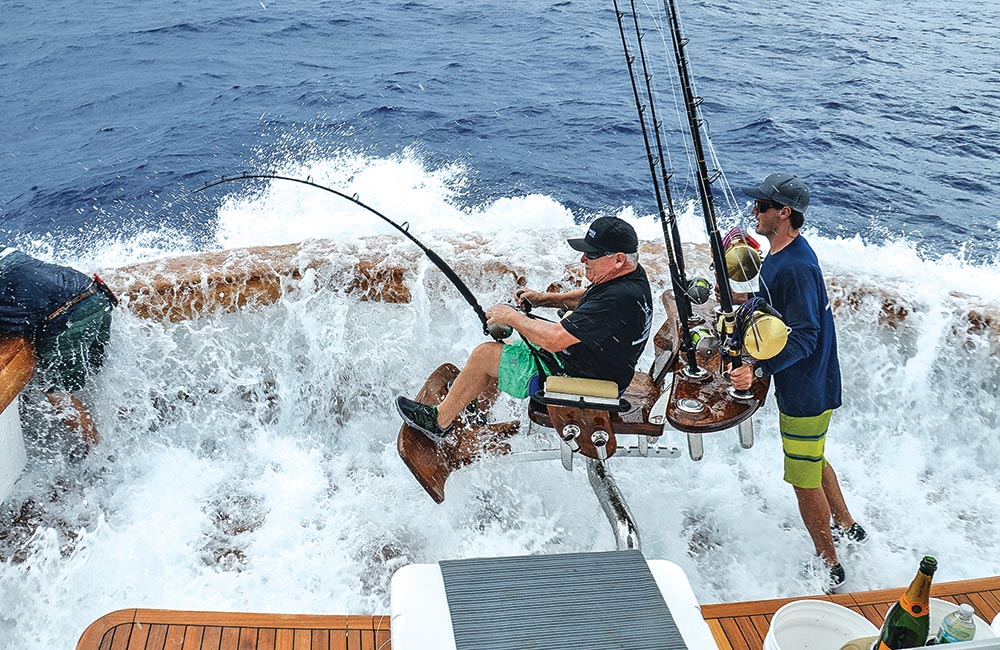
Moore also fingered a different dilemma he’s encountered while trolling from a 92-footer. “Our boat has a 3.23-to-1 gear ratio and huge props, and as a result, there’s very little white water,” he explained. “That makes it really easy for a marlin to cross from one side to the other. The wash that might usually create lanes and cause a fish to hesitate before crossing over just isn’t there. When teasing, we had to learn to speed things up a bit in order to keep the fish’s attention.”
Part of the solution was upgrading their dredge reels to 24-volt Lindgren Pitmans. The new SV-2400 is 50 percent faster than the standard 12-volt S-1200 electric reel, and can put out 150 pounds of pulling power compared with 60 pounds. That means the dredges come up faster — much faster — and according to Moore, that helps quite a bit when you need to react quickly.
Moore has also discovered that when fish come up on a bait instead of a dredge or teaser, the sheer size of your spread can actually work against you in a different way. “Our outriggers spread 120 feet,” he explained. “That’s really, really wide, which can be both a good thing and a bad thing. Sure, we like to be able to spread out the lines, and we worked with Palm Beach Towers to get the widest spread we could with the outriggers. But depending on where a fish is in the spread, sometimes it can be too wide. If the fish comes in on a bait and then decides to leave it, the other lines might be really far away. It’s just a matter of the outriggers spreading everything out so much. On a smaller boat, the fish might be able to look at a number of baits easily, but sometimes, in our case, it might have to see 100 feet or so to spot another one.”
“Sometimes I can turn the boat to bring a different bait toward him, but not all the time,” he says. “It depends on where the fish is, and figuring out the right move isn’t always easy. There’s definitely a learning curve.”
He also noted that when multiples are on the line, how you handle the boat becomes particularly important. “You have to stay upwind of the fish,” he says, “and go after the farthest upwind fish first. Otherwise, you can end up downwind of one or both fish, and you just become a kite.”
A Tactical Advantage
Some of the very same issues, however, also present an advantage. The clean water Moore noted might be problematic when a billfish decides to abandon a teaser and cross sides, but having that clean water is an advantage in the first place because baits are almost never obscured by the wash. And this characteristic isn't unique to Fa La Me.
“We’ve noticed that the larger boats have a surprisingly clean wake while trolling,” Bayliss points out. “We’ve been using a slightly deeper gear ratio on the large boats, and they are amazingly clean at marlin-trolling speeds. I haven’t seen where any of the big boats are underproductive at all. Not only are they seeing their share of bites, they actually might be a little better in some cases.”
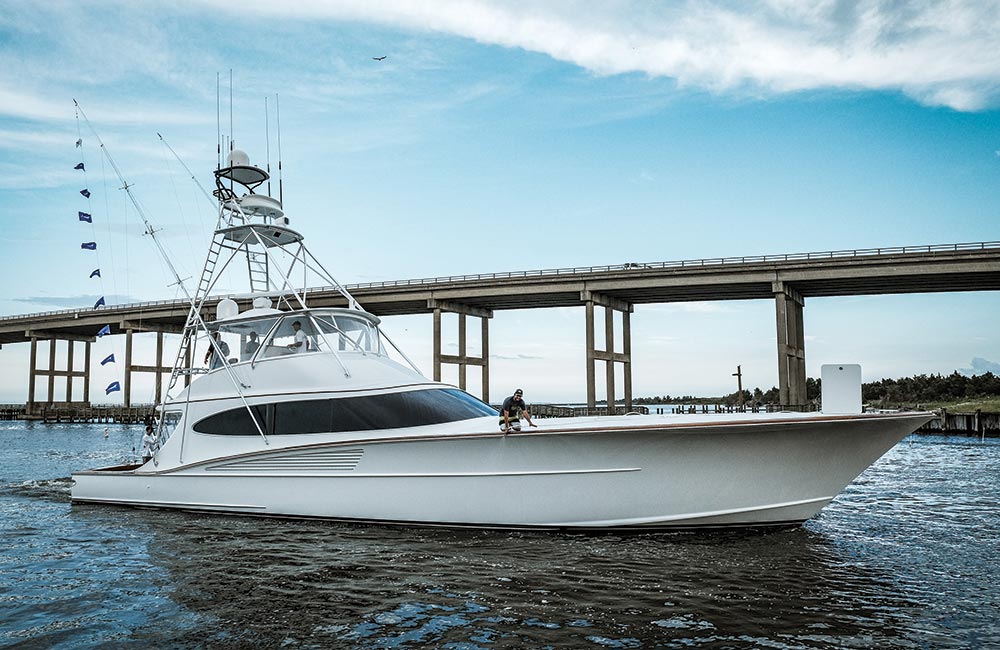
Then, of course, are the obvious advantages that come with size. Cockpits are larger, storage for rods and tackle becomes less of an issue, refrigerator and freezer capacities go up, there is plenty of room for additional guests and crew, and rough sea conditions become easier to handle. Add enclosed bridges, more seating and more-extensive wireless communications systems, and comfort levels go way up. While there will always be conditions best described as unfishable, those days become less frequent as boats get larger.
Gyroscopic stabilization was another item brought up among all the captains and builders. While it usually might not be thought of as a fishing asset, in reality, it does benefit in ways beyond mere comfort.
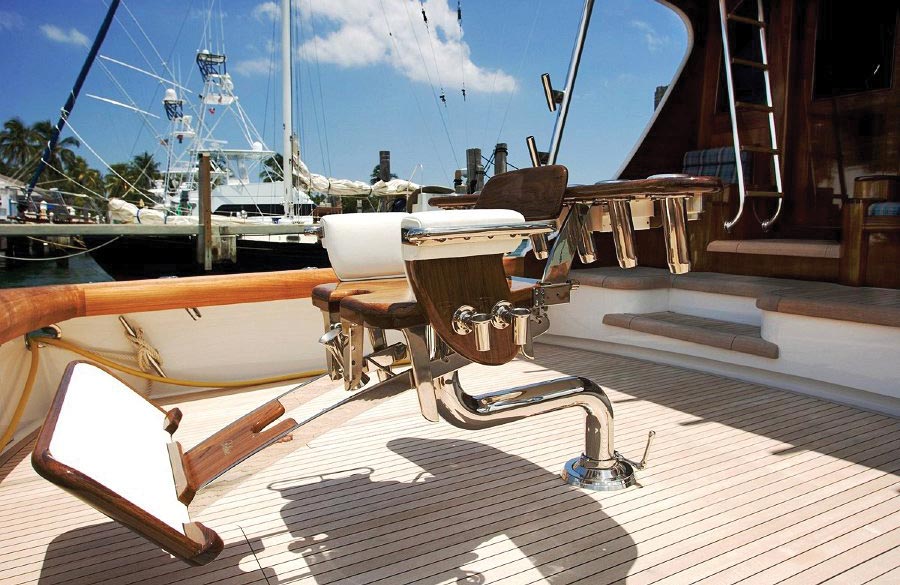
It allows anglers using stand-up gear to move around the cockpit faster and with more confidence, and deckhands can wire and gaff more easily in difficult conditions. A stabilizer can even improve the captain’s view of the action below, since visibility isn’t obscured as the boat rocks from side to side.
Dream Big
With boats now topping the 100-foot mark, will competitive sport-fishing machines grow even larger? To some extent, that depends on what the market demands. The size growth to date has been customer-driven, with builders merely responding to what owners say they want and what technology allows. And if owners say they want a larger boat, builders are sure to respond — but it won’t necessarily be easy.
“Today, our greatest limiting factor is infrastructure,” says Jim Weaver, of Weaver Boatworks. “The facilities, the lifts — everything has to grow with the boats. Longer also means wider, more systems to take care of, and fewer places that can handle servicing the boat. I’m sure we’ll see more big boats, but there might be a limit.”
John Bayliss identified the same sorts of potentially limiting factors. “Dockage and shore-power availability worldwide are another wild card,” he says. “That will need to progress with the boats, if they keep getting bigger.”
Some other builders identify the same issues but believe they can work around them to construct even larger fishing boats. “The maneuverability and throttle response of today’s big boats is so incredible, and there’s no doubt having a hydraulic bow thruster button right there next to your finger on a joystick or lever really helps, so it’s clear that the things that used to stop us from going bigger just aren’t the issues they used to be,” says Randy Ramsey of Jarrett Bay Boatworks, which recently launched a 90-footer. “Yes, these boats need big facilities to service them, and we’ll also need bigger engines to keep growing in size. But these are worldwide boats we’re talking about. While some places might not be able to handle them, others will.
"And when we can get our hands on 3,000-horsepower engines, you can bet the boats will get bigger.” —Randy Ramsey, Jarrett Bay Boatworks
Viking’s Capt. Ryan Higgins is on the same page. “There have already been several owners of our 92-footers who want us to push the envelope again with an even larger Viking sportfish,” he says. And he also points out that these boats can travel longer and farther between stops, thanks to the sheer volume afforded, like additional freezer space, larger pantry areas, and better accommodations. This can reduce the frequency of the need for infrastructure that might be lacking in one place or another.
“Fifteen years ago, I never would have guessed boats over 90 feet would be out on the tournament trail winning big events,” he says. “Back then, it seemed like a 60-footer was big. But as long as technology keeps advancing and we can build larger boats lighter and faster, I think you’ll see us progress with a larger model. Maintaining performance and maneuverability will keep the captain and crews competitive, and the massive interior volume and luxury that boats like the 92 offer will continue making these large boats successful — and will increase the demand for even larger builds.” Bigger is indeed better.
The bottom line? When it comes to fishing competitively, there might not be such a thing as too big, at least not for the sport-fishing boats that are currently in production. Thanks mostly to technology, today’s 90-footer is like yesterday’s 60-footer. The tournament results have already provided the proof, and the real-world experiences of the captains, builders and owners back it up.


